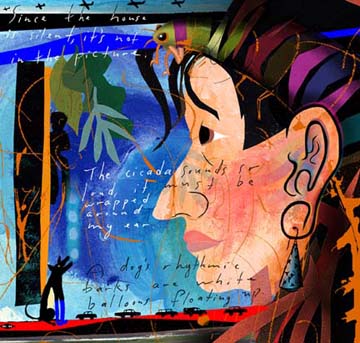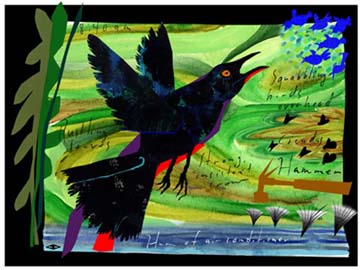
A SEA OF SOUNDStory and Art By Karen Blessen
I hear the sharp tone of the voice on the phone.In response, my own voice becomes more insistent. I’m trying to listen, but my internal chatter is repetitive and destructive. After I hang up, I stop what I’m doing. step outside, close my eyes, tune in, and listen. I let the sound waves lap into my ears, and wait for the sounds to make pictures. It’s a private game -- useful at moments when it seems as though nothing else is working. It’s a non-pharmaceutical way to calm down. We live in a noisy, crazy world. Our days are interrupted by the nerve jangling blips and bleeps of talk radio, cell phones, voices arguing, jackhammers, leaf blowers,chain saws, car alarms, and disturbing song lyrics. We ingest this stuff at a rate that doesn’t allow for a running evaluation of it’s effect on us. Dominating radio shrinks, know-it-all political pundits, and shock jocks are our current models for one-way communication. The loudest get the most attention -- and yet somehow seem to know the least. In our professional lives, on television, and among our friends and family members, everybody’s talking and few are listening. Sentences and voices spill over one another. Thoughts go uncompleted and unacknowledged. Not being heard can feel like not being alive. In our rush to be active, important, and powerful, our culture diminishes the value of the more passive act of listening. We pay professionals to listen to us for 45 minutes. Yet, in the ancient wisdom of various faiths, compassionate listening is a noble pursuit. While we work to articulate our own ‘voice’, does anyone around us really hear it? Writer Fran Lebowitz said "The opposite of talking isn’t listening. The opposite of talking is waiting." I hear her. In his memoir, Speak, Memory, Vladimir Nabokov discussed his more (delete) hallucinogenic approach to listening. He described a process in which the sound of letters turned into colors in his mind. Without addressing whether or not this ability allowed him to truly hear the content of another’s thoughts, he talked about the phantasmagoria that the sounds and colors of the alphabet conjured up for him. The long ‘a’ in the English alphabet became the tint of weathered wood, while a French ‘a’ was the color of polished ebony. To him, ‘x’ was steely blue, and ‘s’ was "a curious mixture of azure and mother-of-pearl." Nabokov’s mother had related abilities. While music affected her son "merely as an arbitrary succession of more of less irritating sounds," to her, it became color. This experience has names. ‘Synesthesia’ is defined as "the subjective sensation or image of a sense (as of color) other than the one (as of sound) being stimulated." Another name is ‘audition colorée’. I believe that this sensation is available to all of us, given the imaginative time to develop and practice. But the art of listening is more than that. In my own way, I also experience this. For as long as I can remember, I’ve "seen" color when I’ve heard music. My perceptions have their own peculiarities. The music of the Artist formerly known as Prince comes in like fireworks - explosive, clear color. By contrast, Bruce Springsteen’s songs and melodies register in muddy tones -- and are virtually unlistenable for me. But, until several years ago I never attempted to pin down these fleeting moments. My first recordings of ‘sound pictures’ happened on a dogpile of a day. I’d suffered through computer meltdowns, projects due, phones, faxes, deliveries, a misunderstanding and heated discussions. I’d had more than one conversation when I’d felt myself doing more ‘waiting’ than ‘listening’. 
At sundown, I took the dogs for a walk. We got home, and I sat down at the picnic table, closed my eyes, and simply listened. The dogs padded around on crunchy leaves. Their tags jingled. A jet hummed overhead. A raucous crow cawed just a few feet away. I heard the neighbor snapping branches into pieces. A picture formed in my head and I had the urge to draw it. I brought out a big tablet of newsprint and a magic marker, closed my eyes and put pen to paper. A picture formed by sound has it’s own hierarchy and imagery. A close-by crow is louder than a jet thousands of feet overhead, so the crow is ten times as big. The cicada sounds so loud, it must be wrapped around my ear. Since the house is silent, it’s not in the picture. An annoying voice turns into arrows hurled. The wind is so constant that it’s a solid wall of horizontal bands behind everything else. I opened my eyes and smiled at the results. All the things that had earlier bothered me so much were nowhere to be seen. Helen Keller mourned her inability to hear. She wrote: I am just as deaf as I am blind. The problems of deafness are deeper and more complex, if not more important, than those of blindness. Deafness is a much worse misfortune. For it means the loss of the most vital stimulus -- the sound of the voice that brings language, sets thoughts astir and keeps us in the intellectual company of man. ...If I could live again I should do much more than I have for the deaf. I have found deafness to be a much greater handicap than blindness. My ‘sound pictures’ are a centering, meditative act. Over the years, different times have created different pictures. If I find myself without a sketchbook, I list the sounds, imagine how far away they are, and place myself in their presence. In the waiting room at New York’s Grand Central Station, I hear soft French accents, squeaking wheels of mop buckets, hurried footsteps, and briefcases being zipped open and closed. In my life in Texas, there are sounds that are often with me -- car wheels on pavement, leaves rustling in the breeze, a dog barking, slamming doors, air conditioners, birds, and running water. On one soft summer day, the breeze becomes small overlapping ovals of light greens and turquoises. Another time, the wind is washes of soggy olive green and ochre. A dog’s rhythmic barks are white balloons floating up. This still doesn’t get down to the power of listening and being listened to. What about the living, vital, exchange with another human being? What brings us into the revolving cast of speakers and listeners -- the "company of man"? How do we hear "the sound of the voice that brings language?" Talk comes in many hues. It can be amusing entertainment, seduction, a way to kill time, a distancing mechanism, cheap domination, honest words said with good intentions, and, at it’s most powerful, deep feelings spoken out loud. If you’ve cut me off and I don’t feel heard, I’m rejected. I don’t feel as though I’m truly alive to you. If I shut my ears to you, it’s a bloodless execution. On the other hand, if your voice softly winds its way deep inside me, you’ve become a part of me. If you’ve listened to me, you’ve let me in your life. We as humans crave this. The real art of listening is a generous act of love -- of entry into the mystery of one another. SOUND PICTURES -- HOW TO TUNE IN AND DRAWFor me, ‘noise’, ‘sound’, and ‘listening’ come loaded with liquid imagery. Sounds and voices come in waves, ‘lap’ into our ears, and then into our brain, which is about 80% water. Noise and over-stimulation bring churning waters - like an outboard motor spewing out foam. It interests me that the ear, our instrument of hearing and balance, contains pockets of fluids. When I do my sound pictures, listening begets transformation. It focuses my attention outside myself, brings me into the present, and lifts my spirits. The need to raise a ruckus is balanced with the opportunity to "hear". I enter a state of mind where I’m more able to listen -- and speak -- lovingly. Equilibrium is restored. And the little lakes deep inside my head are calm. This is my process:
|
ALL STORIES:: One By One By One:: One Bullet :: In Mom's Eyes :: Luck :: A Sea of Sound :: Diary of a Confetti Engineer :: What Did He See From the Mountaintop? :: Faces of a Plague :: What turns compassion into action? :: Today Marks the Beginning If you are interested in scheduling Karen Blessen for a speaking engagement or workshop, please call 214-827-3257 or e-mail kblessen@aol.com |
Contact Karen Blessen :: kblessen@sbcglobal.net :: Karen@29Pieces.org :: kblessen@TodayMarkstheBeginning.org :: 214-827-3257 :: Email Webmaster
KarenBlessen.com. Artist and writer. Cut paper collages, illustrations,
drawings, prints, stories, journal entries, public art, and photographs are
copyright Karen Blessen unless otherwise noted.
